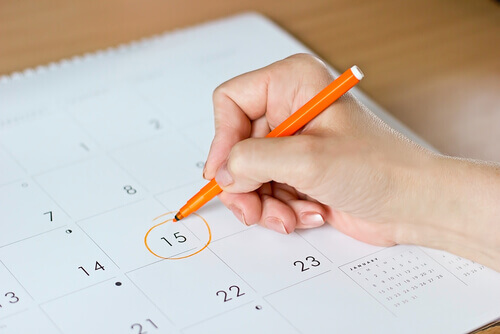The Importance of Teaching Our Daughters to Monitor Their Menstrual Cycles

One of the most complex stages our daughters will go through is starting their menstrual cycles. They will have many questions and go through sudden changes which is why it’s normal for a bit of confusion to arise.
As parents it’s important for us to explain to them why the process happens and how to properly monitor a menstrual cycle.
So, how should we address the menstrual cycle? It is important for your daughter to know that she can trust you and convey any concerns she may have. It is also important for her to know everything about the menstrual cycle and how to keep track of the days until she’ll have her next cycle.
Sometimes, a girl’s first cycles are irregular. However, with time, they should begin to regularize. If you notice that your daughter’s menstrual cycle doesn’t become regular after a while, consult a gynecologist to perform an evaluation.
How does monitoring her menstrual cycle help?
Your daughter may not have learned about this topic at school, which is why it’s very important for parents to teach her.
So, why should she know how to monitor her menstrual cycle? The answer is simple: it will help your daughter be more involved with her body and the changes that have started to occur in it.
It will also teach her that it’s important to monitor certain health factors. Irregular menstrual cycles can sometimes be linked to certain diseases.
Furthermore, keeping track of the menstrual cycle will help girls in the following ways:
- It helps them get to know their own bodies.
- It gives them the possibility to notice irregularities in order to consult their doctors.
- This knowledge can help inform them about life cycles.
- It helps them be more cautious.

Ways to monitor menstrual cycles
There are many ways to keep track of menstrual cycles and now technology can also be used as a very effective tool. Here are some of the most common methods to keep track of menstrual cycles:
Use a calendar
The simplest way is to simply record the days on which the menstrual cycle beings and ends on a calendar. This can be done with a simple calendar or using a cell phone. With cell phones they will also be able to set an alarm to alert them when the next cycle should begin. This is one of the most widely used methods.
Lunar diagram
A lunar diagram is a tool that can help divide the menstrual cycle into four phases. This division can help give a deeper understanding about the body and mind’s needs during each moment of the cycle. This method is less used than the calendar method but it is quite practical.
The lunar method consists of three or four phases. The 28 days of the cycle are placed into the diagram and adjusted to fit the cycle. During the next cycle the days should be written according to the Gregorian calendar, that is to say that if your period begins on October 12, you’ll have to put that as day 1 of your menstrual cycle.
Thermic method
This method allows women to know about the physiological aspects of their menstrual cycles. Certain signs help indicate which phase of the menstruation is occurring. This can be determined through measurement of basal temperature, the observation of vaginal discharge or the position of the cervix.
Mobile applications
Apps are becoming more and more common nowadays. These applications are very easy to use. There are many well-known apps such as Iperiod, which allows women to indicate the days of the menstrual cycle and then it makes an estimation of when the next one should start.
The information that these apps provide are mainly indicative and they shouldn’t be taken as 100% accurate.
Another useful app is Kindara. Unlike Iperiod, Kindara is very detailed and it has a lot of great graphics.

What to do when your daughter has her first period?
First of all, talk to her, give her all the information she needs in order to make her understand that this is a change that she’ll adapt to as time goes by. Here are a few guidelines:
- Congratulate her for her first cycle. Congratulate her because this occurrence indicates her maturity.
- Avoid transmitting negative aspects. Her first cycle has to be seen as a positive occurrence, not a negative one.
- Advise her on hygiene. Advise her on how her hygiene should be while menstruating.
- Guide her. Give her the best information available about her menstruation and the changes occurring in her body.
- Teach her to be prepared. Whenever your daughter leaves the house she should always have some tampons or pads handy in her bag.
The most important thing is for your daughter to understand that getting her period is not a negative thing nor is it something that will change her lifestyle. It is a completely normal process that happens to every girl who is going through puberty, not just her.
One of the most complex stages our daughters will go through is starting their menstrual cycles. They will have many questions and go through sudden changes which is why it’s normal for a bit of confusion to arise.
As parents it’s important for us to explain to them why the process happens and how to properly monitor a menstrual cycle.
So, how should we address the menstrual cycle? It is important for your daughter to know that she can trust you and convey any concerns she may have. It is also important for her to know everything about the menstrual cycle and how to keep track of the days until she’ll have her next cycle.
Sometimes, a girl’s first cycles are irregular. However, with time, they should begin to regularize. If you notice that your daughter’s menstrual cycle doesn’t become regular after a while, consult a gynecologist to perform an evaluation.
How does monitoring her menstrual cycle help?
Your daughter may not have learned about this topic at school, which is why it’s very important for parents to teach her.
So, why should she know how to monitor her menstrual cycle? The answer is simple: it will help your daughter be more involved with her body and the changes that have started to occur in it.
It will also teach her that it’s important to monitor certain health factors. Irregular menstrual cycles can sometimes be linked to certain diseases.
Furthermore, keeping track of the menstrual cycle will help girls in the following ways:
- It helps them get to know their own bodies.
- It gives them the possibility to notice irregularities in order to consult their doctors.
- This knowledge can help inform them about life cycles.
- It helps them be more cautious.

Ways to monitor menstrual cycles
There are many ways to keep track of menstrual cycles and now technology can also be used as a very effective tool. Here are some of the most common methods to keep track of menstrual cycles:
Use a calendar
The simplest way is to simply record the days on which the menstrual cycle beings and ends on a calendar. This can be done with a simple calendar or using a cell phone. With cell phones they will also be able to set an alarm to alert them when the next cycle should begin. This is one of the most widely used methods.
Lunar diagram
A lunar diagram is a tool that can help divide the menstrual cycle into four phases. This division can help give a deeper understanding about the body and mind’s needs during each moment of the cycle. This method is less used than the calendar method but it is quite practical.
The lunar method consists of three or four phases. The 28 days of the cycle are placed into the diagram and adjusted to fit the cycle. During the next cycle the days should be written according to the Gregorian calendar, that is to say that if your period begins on October 12, you’ll have to put that as day 1 of your menstrual cycle.
Thermic method
This method allows women to know about the physiological aspects of their menstrual cycles. Certain signs help indicate which phase of the menstruation is occurring. This can be determined through measurement of basal temperature, the observation of vaginal discharge or the position of the cervix.
Mobile applications
Apps are becoming more and more common nowadays. These applications are very easy to use. There are many well-known apps such as Iperiod, which allows women to indicate the days of the menstrual cycle and then it makes an estimation of when the next one should start.
The information that these apps provide are mainly indicative and they shouldn’t be taken as 100% accurate.
Another useful app is Kindara. Unlike Iperiod, Kindara is very detailed and it has a lot of great graphics.

What to do when your daughter has her first period?
First of all, talk to her, give her all the information she needs in order to make her understand that this is a change that she’ll adapt to as time goes by. Here are a few guidelines:
- Congratulate her for her first cycle. Congratulate her because this occurrence indicates her maturity.
- Avoid transmitting negative aspects. Her first cycle has to be seen as a positive occurrence, not a negative one.
- Advise her on hygiene. Advise her on how her hygiene should be while menstruating.
- Guide her. Give her the best information available about her menstruation and the changes occurring in her body.
- Teach her to be prepared. Whenever your daughter leaves the house she should always have some tampons or pads handy in her bag.
The most important thing is for your daughter to understand that getting her period is not a negative thing nor is it something that will change her lifestyle. It is a completely normal process that happens to every girl who is going through puberty, not just her.
All cited sources were thoroughly reviewed by our team to ensure their quality, reliability, currency, and validity. The bibliography of this article was considered reliable and of academic or scientific accuracy.
- Knudston, J. Ciclo menstrual. Manual MSD – Versión para público general. [En línea].
- Principales preguntas sobre tu ciclo menstrual. Una hoja de datos de la oficina para la salud de la mujer. Office on Women’s Health. [En línea]
- Salud femenina: riesgos, señales de alerta y prevención. Allianz Worldwide Care. La salud a examen 2017. [En línea].
This text is provided for informational purposes only and does not replace consultation with a professional. If in doubt, consult your specialist.








